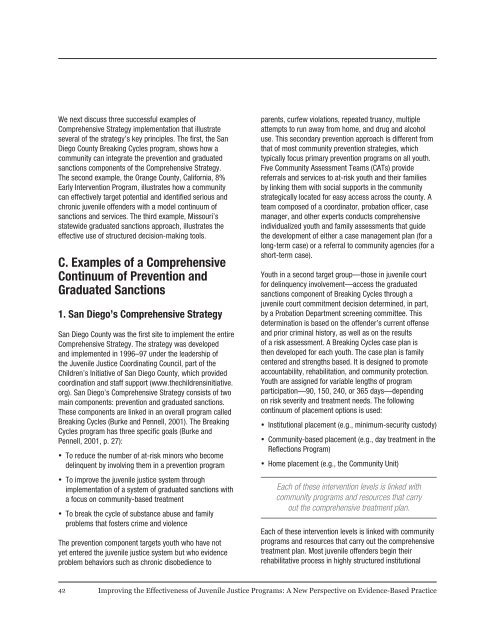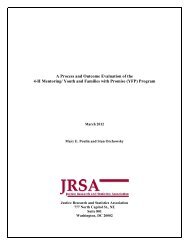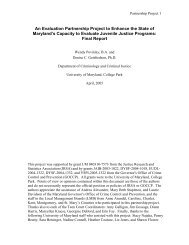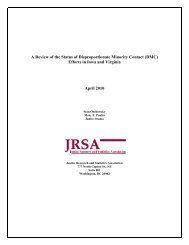Improving the Effectiveness of Juvenile Justice Programs: A New
Improving the Effectiveness of Juvenile Justice Programs: A New
Improving the Effectiveness of Juvenile Justice Programs: A New
Create successful ePaper yourself
Turn your PDF publications into a flip-book with our unique Google optimized e-Paper software.
We next discuss three successful examples <strong>of</strong><br />
Comprehensive Strategy implementation that illustrate<br />
several <strong>of</strong> <strong>the</strong> strategy’s key principles. The first, <strong>the</strong> San<br />
Diego County Breaking Cycles program, shows how a<br />
community can integrate <strong>the</strong> prevention and graduated<br />
sanctions components <strong>of</strong> <strong>the</strong> Comprehensive Strategy.<br />
The second example, <strong>the</strong> Orange County, California, 8%<br />
Early Intervention Program, illustrates how a community<br />
can effectively target potential and identified serious and<br />
chronic juvenile <strong>of</strong>fenders with a model continuum <strong>of</strong><br />
sanctions and services. The third example, Missouri’s<br />
statewide graduated sanctions approach, illustrates <strong>the</strong><br />
effective use <strong>of</strong> structured decision-making tools.<br />
C. Examples <strong>of</strong> a Comprehensive<br />
Continuum <strong>of</strong> Prevention and<br />
Graduated Sanctions<br />
1. San Diego’s Comprehensive Strategy<br />
San Diego County was <strong>the</strong> first site to implement <strong>the</strong> entire<br />
Comprehensive Strategy. The strategy was developed<br />
and implemented in 1996–97 under <strong>the</strong> leadership <strong>of</strong><br />
<strong>the</strong> <strong>Juvenile</strong> <strong>Justice</strong> Coordinating Council, part <strong>of</strong> <strong>the</strong><br />
Children’s Initiative <strong>of</strong> San Diego County, which provided<br />
coordination and staff support (www.<strong>the</strong>childrensinitiative.<br />
org). San Diego’s Comprehensive Strategy consists <strong>of</strong> two<br />
main components: prevention and graduated sanctions.<br />
These components are linked in an overall program called<br />
Breaking Cycles (Burke and Pennell, 2001). The Breaking<br />
Cycles program has three specific goals (Burke and<br />
Pennell, 2001, p. 27):<br />
• To reduce <strong>the</strong> number <strong>of</strong> at-risk minors who become<br />
delinquent by involving <strong>the</strong>m in a prevention program<br />
• To improve <strong>the</strong> juvenile justice system through<br />
implementation <strong>of</strong> a system <strong>of</strong> graduated sanctions with<br />
a focus on community-based treatment<br />
• To break <strong>the</strong> cycle <strong>of</strong> substance abuse and family<br />
problems that fosters crime and violence<br />
The prevention component targets youth who have not<br />
yet entered <strong>the</strong> juvenile justice system but who evidence<br />
problem behaviors such as chronic disobedience to<br />
parents, curfew violations, repeated truancy, multiple<br />
attempts to run away from home, and drug and alcohol<br />
use. This secondary prevention approach is different from<br />
that <strong>of</strong> most community prevention strategies, which<br />
typically focus primary prevention programs on all youth.<br />
Five Community Assessment Teams (CATs) provide<br />
referrals and services to at-risk youth and <strong>the</strong>ir families<br />
by linking <strong>the</strong>m with social supports in <strong>the</strong> community<br />
strategically located for easy access across <strong>the</strong> county. A<br />
team composed <strong>of</strong> a coordinator, probation <strong>of</strong>ficer, case<br />
manager, and o<strong>the</strong>r experts conducts comprehensive<br />
individualized youth and family assessments that guide<br />
<strong>the</strong> development <strong>of</strong> ei<strong>the</strong>r a case management plan (for a<br />
long-term case) or a referral to community agencies (for a<br />
short-term case).<br />
Youth in a second target group—those in juvenile court<br />
for delinquency involvement—access <strong>the</strong> graduated<br />
sanctions component <strong>of</strong> Breaking Cycles through a<br />
juvenile court commitment decision determined, in part,<br />
by a Probation Department screening committee. This<br />
determination is based on <strong>the</strong> <strong>of</strong>fender’s current <strong>of</strong>fense<br />
and prior criminal history, as well as on <strong>the</strong> results<br />
<strong>of</strong> a risk assessment. A Breaking Cycles case plan is<br />
<strong>the</strong>n developed for each youth. The case plan is family<br />
centered and strengths based. It is designed to promote<br />
accountability, rehabilitation, and community protection.<br />
Youth are assigned for variable lengths <strong>of</strong> program<br />
participation—90, 150, 240, or 365 days—depending<br />
on risk severity and treatment needs. The following<br />
continuum <strong>of</strong> placement options is used:<br />
• Institutional placement (e.g., minimum-security custody)<br />
• Community-based placement (e.g., day treatment in <strong>the</strong><br />
Reflections Program)<br />
• Home placement (e.g., <strong>the</strong> Community Unit)<br />
Each <strong>of</strong> <strong>the</strong>se intervention levels is linked with<br />
community programs and resources that carry<br />
out <strong>the</strong> comprehensive treatment plan.<br />
Each <strong>of</strong> <strong>the</strong>se intervention levels is linked with community<br />
programs and resources that carry out <strong>the</strong> comprehensive<br />
treatment plan. Most juvenile <strong>of</strong>fenders begin <strong>the</strong>ir<br />
rehabilitative process in highly structured institutional<br />
42 <strong>Improving</strong> <strong>the</strong> <strong>Effectiveness</strong> <strong>of</strong> <strong>Juvenile</strong> <strong>Justice</strong> <strong>Programs</strong>: A <strong>New</strong> Perspective on Evidence-Based Practice

















